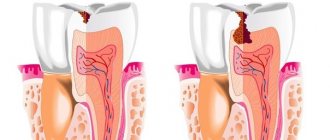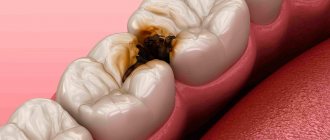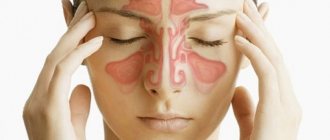How to determine?
There are several signs by which you can immediately understand that a tooth is growing in the wrong direction. This is evidenced by:
- Pain at the end of the dentition.
- Pain and bleeding from mechanical stress, such as brushing teeth or chewing hard food.
- Swelling and hyperemia of the soft tissues near the inside of the cheek.
- Most often, the teething process is delayed for several months or even several years.
- It is visually noticeable that the apex of the tooth is located abnormally.
Why do gums recede with crowns and veneers?
Veneers or crowns also sometimes cause gum recession.
The issue may be the quality of the restorations themselves. For example, if the edge of the prosthesis adjacent to the mucous membrane is more massive than necessary and literally does not fit under the gum. Normally, veneers and crowns are created with a beveled edge, that is, they are thinner in the area adjacent to the gum. It also plays a role how carefully the orthopedist worked and polished the edge of the restoration near the mucosa, and whether he removed the remnants of the fixing cement. The slightest roughness near the neck of the tooth can irritate the soft tissues.
And, of course, the problem arises due to improper care of veneers and crowns: aggressive cleaning with a hard brush or the use of dental floss, which is prohibited after restoration. In addition to the fact that the thread causes cuts to the mucous membrane, it can get caught on the veneer and partially peel it off from the tooth. Then its open edge can injure the gums.
What to do?
If a wisdom tooth causes severe discomfort and erupts in the wrong position, it will most likely have to be removed; there is no other solution to the problem. It is better to entrust such complex dental removal to a real professional so that the procedure is carried out according to all the rules. First you need to carry out diagnostics to understand the exact location of the unit. For this purpose, an X-ray of the jaw is performed. Let's consider a step-by-step algorithm for surgical intervention:
- Use of local anesthetic. High-quality long-acting medications are needed, since wisdom tooth removal can take several hours.
- Excision of soft tissue is performed.
- Using a drill to create access to the tooth root.
- Using special forceps, the tooth is removed from the oral cavity.
- The wound is carefully treated with antiseptic agents.
- Stitches are required to stop the bleeding.
Many patients ask the same question: is it possible to leave a tooth in the mouth and not remove it? Experts say that this is quite possible if the new unit does not cause pain or discomfort and does not interfere with neighboring teeth.
Why do the necks of the teeth become exposed?
Exposure of the neck of the tooth, the causes and treatment of which are closely related, can cause the patient to have:
- Atrophic gingivitis. Inflammation and swelling of the gums occurs, bleeding occurs, as a result of which the volume of tissue decreases and the neck of the teeth is exposed.
- Periodontitis. In the space between the teeth, the accumulation of pathogenic microorganisms, plaque, and the formation of tartar begins. Next, the soft tissue and ligaments that support the tooth are destroyed. There is a gradual resorption of bone tissue and subsidence of the gums, as a result of which the part of the tooth that should be under the gum is exposed.
- Caries of the cervical zone. When a tooth is damaged by caries, bacteria begin to multiply in the upper part of the crown and the gum tissue is destroyed.
- Improper oral hygiene. Carrying out poor hygiene measures or too intense movements with a toothbrush can cause microtrauma to the gums, the proliferation of bacteria, which results in the development of gum disease, and then the neck of the tooth is exposed.
- Anatomical features of the bite. With crowded teeth, short frenulum or small vestibule of the oral cavity.
- Age-related changes in tissue. This occurs mainly in older people.
- Bruxism. Grinding of teeth and clenching them tightly leads to exposure of the cervix.
- Diseases of the gastrointestinal tract. The altered acidity of saliva, which in most cases is present in gastrointestinal diseases, destroys the enamel. In addition, bacteria begin to multiply in the mouth, pathological processes occur in the soft tissues, as a result of which the neck becomes bare.
Considering the reason why the neck of the tooth is exposed, the disease develops at different rates and different consequences arise.
Symptoms
When the dental neck becomes exposed, it is visible to the naked eye. Especially if the problem concerns the front teeth. The hidden part of the tooth differs from the enamel in yellow. In addition to these signs, you can suspect that the cervix is exposed based on the following symptoms:
- Spicy, sour, cold and hot foods cause pain in all teeth at once.
- Brushing your teeth is an unpleasant experience.
- The gums become swollen, swollen, and inflamed.
- When passing along the gingival margin, the presence of unevenness (steps) is felt.
- The fragility of teeth increases.
- The roots are affected by caries.
- Visual elongation of the tooth, as the edge of the gum has shifted. Visually, it seems that the gap between the teeth has increased.
- The inflammatory process causes the appearance of a periodontal pocket in which pus will accumulate.
- The appearance of a putrid odor in their mouth.
- A weakened tooth is not securely fixed in the gum, increasing the risk of tooth loss.
Recommendations after tooth extraction
Removing a complex tooth is considered a full-fledged operation. For this reason, dentists recommend carefully observing the rehabilitation period so as not to provoke the development of complications:
- At the end of the dental procedure, the doctor places a gauze pad. Do not rush to remove it from your mouth; keep the turunda in your mouth for at least 15 minutes.
- When you get home, apply a cool compress to your cheek. This will help avoid severe swelling and soothe the aching pain.
- Do not self-medicate, take only those medications prescribed by the doctor.
- Rinsing the mouth is only permissible on the recommendation of a doctor. As a rule, short-term antiseptic baths are done to prevent the proliferation of pathogenic microflora.
- Monitor your body temperature. If it increases, you should see a dentist.
- Do not heat your tooth under any circumstances. Don't take a bath and limit strenuous physical activity for a week.
- Eat soft foods that can be consumed through a straw.
- If you experience disturbing symptoms, do not ignore going to the doctor.
- If after the end of the painkiller you are in pain, you are allowed to take a painkiller tablet in accordance with the instructions.
Symptoms
Usually the problem is typical for molars - chewing teeth. You should be alarmed by the fact that the child’s baby tooth does not fall out. Due to its fusion with the bone, it simply cannot be easily separated from the alveoli, as is normal, and remains in it.
Subsequently, the child’s jaw begins to develop incorrectly. The tooth is located noticeably lower than the others in the row, and the neighboring teeth are turned at an angle relative to it. This leads to significant bite problems and the inability to close teeth normally. Due to the lack of normal chewing load, the antagonist tooth on the opposite jaw gradually becomes loose and falls out.
Tooth ankylosis has other development options. The baby tooth may not fully erupt, as if it has slowed down in its development. Also, the growth of a baby tooth may be severely delayed, which is why a permanent tooth cannot develop normally in its place. As a result, the temporary tooth falls out, and the permanent tooth becomes fused to the jaw.
How to get rid of the problem
When wisdom teeth erupt, many try to solve the problem on their own - with the help of medications or traditional methods. Rinsing and pain relief on your own are acceptable measures, but only after visiting the dentist’s office and receiving medical advice.
The following options can be used:
- medications to relieve pain and inflammation;
- surgical solution;
- use of traditional medicine.
It is often most effective to use all options.
Diagnosis of periodontitis
Traditionally, diagnosis begins with a history taking. During a conversation with the patient, the doctor establishes the duration of the disease, studies working conditions and lifestyle, bad habits, and dietary habits. Next, they move on to examining the oral cavity. In addition to receding gums, bleeding gums, bad breath, ulcerative and necrotic lesions and other characteristic symptoms may occur. In order to establish the severity of the disease and assess the extent of damage to all tissues, clinical diagnostic methods are used, which include:
- Schiller-Pisarev test.
- Panoramic or targeted x-rays of teeth.
- Assessment of the resistance of gum capillaries.
- Determination of tooth mobility.
- Measuring the depth of the periodontal pocket.
- Microscopic examination of the biopsy specimen.
- Bacteriological research.
It is not always necessary for a doctor to use all of these methods. Based on the patient’s complaints, clinical picture and general condition of the body, a specific examination regimen is prescribed, which helps confirm or refute the diagnosis.
Dial-Dent specialists who took part in this treatment
- Orthopedic dentist S.V. Zukor – diagnostics, treatment planning, preparation of treatment estimates.
- Surgeon T.R. Zhazykoev – tooth extraction under sedation.
- Anesthesiologist V.S. Kulakov – conducting sedation, monitoring the patient’s condition.
- Dentist-endodontist Yu.A. Borisova – treatment of dental canals under a microscope.
- Dental hygienist E. Smirnova – professional oral hygiene, preparation for dental treatment, selection of hygiene products, training in brushing teeth.
- Dental technician D.V. Wolf – making a temporary denture.
- Dental assistants L. Kharlamova, S. Mirvelova, A. Antoshkina.
See other examples of dental treatment and prosthetics here.
Make an appointment for a consultation by phone +7-499-110-18-04 or through the form on the website. You can ask questions about dental treatment and prosthetics to the chief doctor of the clinic, Sergei Vladimirovich Tsukor, at
Why difficulties arise
Problems can be caused by a number of reasons, including:
- Disturbances in the formation of bone tissue;
- General metabolic disorder;
- Hormonal imbalance;
- Pathological formations in the problem area;
- Incorrect tooth position;
- Lack of free space in the jaw;
- Infection in the root canal;
- Carious cavity;
- Fully hardened and formed bone tissue;
- Inflammation of the gums.
PROMOTION
Inexpensive tooth extraction
from 1000 rub.
Treatment
The success of periodontitis treatment largely depends on how quickly the patient seeks medical help. At the very first signs of gum inflammation, therapeutic procedures are prescribed that can quickly and effectively eliminate this pathology. Unfortunately, this happens quite rarely. Usually a person waits until the last minute and goes to the dentist after the underlying disease begins to progress rapidly. In such cases, long-term and complex treatment is required, which does not always give the desired result.
How wisdom teeth erupt
This process occurs starting from the age of 16 or at a later age. Dentists do not consider the eruption of these teeth to be a deviation even after 40 years.
Over the years, the jaws decrease in size, and there is no room left for the “eights”. If eruption is delayed, an x-ray should be taken to see the reason.
The path of this tooth passes through fairly thick soft tissue, so the following symptoms appear:
- Pain in the problem area or radiating to the jaw;
- Redness;
- Edema;
- Difficulty eating and opening the mouth.
Other manifestations are also possible:
- Second molars suffer from root or cervical caries;
- If the swelling is extensive, the throat and gums may hurt, causing odontogenic sore throat.











